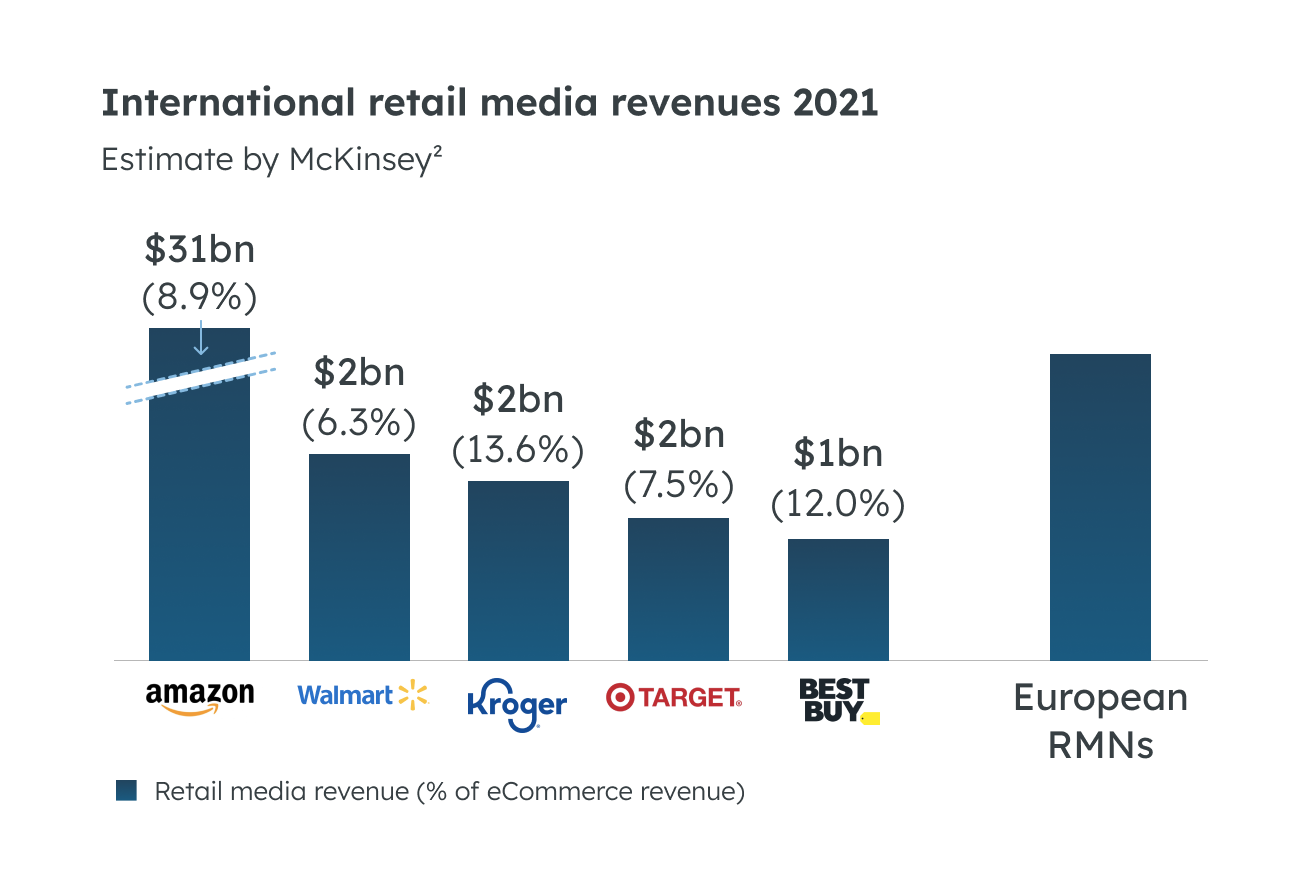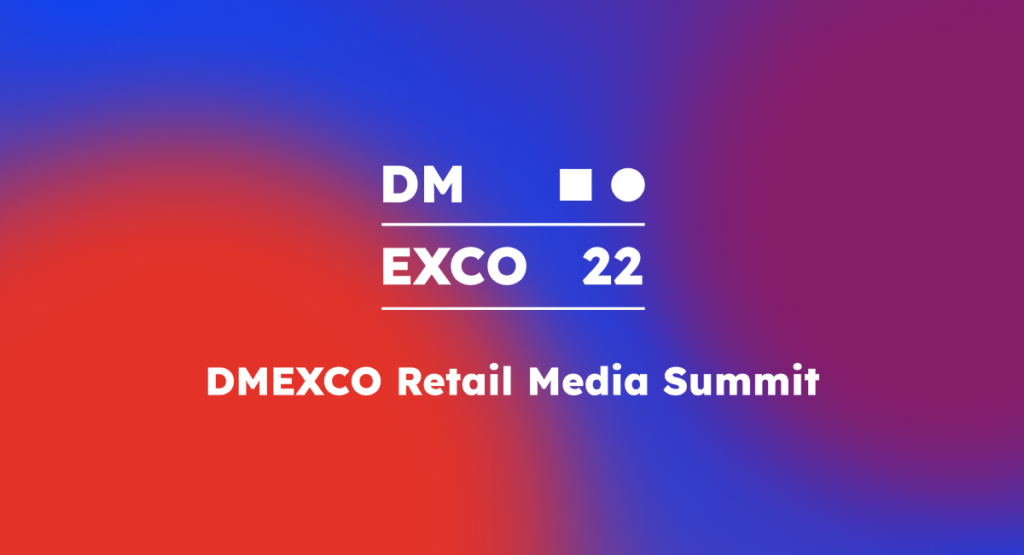Miss DMEXCO 2022 last month? Don’t worry. I’ve got you covered with highlights from Europe’s largest digital marketing and technology event.
Read on as I hone in on sessions related to retail media, the latest boom in digital advertising, and my focus as Senior Product Manager for Crealytics retail media solution. The takeaway countdown begins.
10. European retail media lags the U.S. as a percent of digital advertising
Heard in: Retail Media – a First Impulse | Session link
My take: In the U.S., retail media is the second fastest growing ad format after connected TV (CTV). With a predicted compound annual growth rate of 31% between 2020-2024, the industry is on target to comprise 20% of digital advertising by 2025.

What about European retail media networks?
Retail media spending exceeded $8 billion so far in 2022 and will reach $24.8 billion by 2026. According to McKinsey, Europe is catching up, with growth in the U.K. reaching 10% year-over-year (YoY). In comparison, U.S. retailers are estimated to add a whopping 6%-13% of media revenues on top of their eCommerce sales, but European retail media networks only monetize an additional 3%-4%.

9. Retail media contributes an impressive 12% to Walmart’s bottom line
Heard in: Retail Media – the Reality: Why do retailers struggle to scale, and how can they overcome this? | Session link
My take: According to its annual report, Walmart’s net income equaled about $14 billion for the 2022 fiscal year.. With ad revenues of $2.1 billion, margins need to be as high as 80% to contribute as much as 12% to Walmart’s bottom line.
While this seems like a lot at first, we should consider that retail media gross margins range 70%-90% (onsite) and 20%-40% (offsite). While it varies by category, traditional retail gross margins only deliver 20%-40%.
Retail media is truly a great lever to push the bottom line.

8. Retail media budgets are expected to suffer the least from a recession
Heard in: Several sessions
My take: While there’s the adage branding and TV budgets always lose during a recession, comparatively, retail media budgets may survive. After all, they’re close to the conversion, and attribution indicates that they contribute to ROAS. Here’s two additional thoughts:
- Retail media needs to deliver incremental ROAS: There is a subtle but important difference between attribution and incrementality. Just because marketers see attributed sales in their reports doesn’t mean that the ads were needed to make the sale. There are stories from brands on Amazon who turned their advertising off completely but didn’t lose a single purchase.
- Retail media budgets, tied to ROAS goals: If overall eCommerce sales volume suffers, retail budgets will also take a hit.
7. It’s time for more retail media standards
Heard in: Retail Media Summit
My take: Like the wild, wild west, each retailer defines standards in its retail media network, from ad formats to attribution models and reporting. However, common ground may benefit the industry, especially as it matures.
For example, if we think beyond CPA and ROAS, what are other meaningful long-term (cohort) KPIs? Is there a retail media sibling akin to Customer Lifetime Value to measure and optimize the long-term effects of retail media spending?
Hot topics, the IAB and the German BVDW will discuss these questions soon, with retailers and tech vendors participating.
6. Retailers must quantify their media strategy
Heard in: Retail Media – the Reality: Why do retailers struggle to scale, and how can they overcome this? | Session link
My take: Small, medium, or large: Which retail media strategy will be the right one for any given retailer?
Those that opt for small will integrate out-of-the-box vendors on their website and leverage network demand from third party aggregators. They will build minimum internal resources and look at the additional money as a gift, as they have little influence on it.
On the other hand, retailers that choose large — the Amazon and Walmart path— will build premium walled gardens and run most aspects of their retail media operations in-house: ad-tech stacks, sales, data, and ad-ops, which requires deeper pockets, planning, and competencies.

5. Brands run ads on eight retail media networks (RMNs)
Heard in: The Unparalleled Potential of Commerce Media
My take: Running ads on eight retail media networks, seems like many parallel battles, even when managed through an agency. After all, each network has its proprietary standards.
However, a different survey from The Trade Desk in 2021 stated that 81% of the interviewed shopper marketing decision-makers use only two or three networks.
While these numbers seem very different, they’re probably looking at different ways to access retail media networks. Brands need to prioritize. If they maintain a 1:1 relationship and use managed services to run ads, for their best and most important retailers, it becomes difficult to manage more than two to three networks.
To run ads on lower priority retail media networks, they are more likely to book campaigns on retail media demand-side platforms like Criteo, Skai, Flywheel Digital, and Pacvue, which then deploy the demand to a network of retailers.
Retailers will also need adtech that helps them maximize yield, like header bidding in display. They need to be able to add more demand sources, have a unified auction system across all demand side platforms, and have strong control over ad relevance.
4. Retailers should consider external support to build their retail media network
Heard in: Retail Media Summit – Status-quo and Trends | Session link
My take: This advice comes from Thorsten Ahlers, who built several retail media units for leading German retailers, such as the Otto Group, and currently serves as Managing Director of Media-Saturn Marketing, which earns $25 billion in annual revenue and employs a team of more than 52,000.
Ahlers stressed the importance of planning when retailers become serious about building out their retail media business. Giving detailed thought to the structure will help overcome common, seemingly endless, challenges, such as:
- Finding the right leaders with retail and media expertise.
- Building and financing media teams, keeping in mind that this can easily grow up to 50+ persons, from data to ad-ops and sales.
- Cooperation with merchant teams and setting up governance.
In my experience, retailers strongly benefit from getting hands-on support. Having team extensions on their side who have already successfully handled sales, marketing and ad-ops is a huge help to accelerate operations.
Ready for some hands-on support?
Let’s talk.

3. Separate retail media products from co-op budgets
Heard in: Retail Media Summit – Status-quo and Trends | Session link
My take: The distinction between retail media and co-op is still blurry, and many brands want to deploy pre-negotiated co-op budgets in retail media campaigns. This situation has created a lot of confusion and frustration as retailers seek additional media dollars.
The solution: Retailers need to clearly define which parts of their media offering can be used with co-op budgets – and which are reserved exclusively for retail media. In fact, everything that can be measured based on performance KPIs (Awareness, CPA, ROAS) is a good candidate.
The consequence? Retailers can’t sell media products to their key-account managers on the brand side. They must establish new relations with brands’ marketing teams – or their agencies. A significant challenge with similar consequences as key-takeaway five.
2. Many retailers need a combination of self-serve and managed services
Heard in: Retail Media – the Reality: Why do retailers struggle to scale, and how can they overcome this? | Session link
My take: With many retailers serving several advertiser segments, some brands use media agencies that prefer to manage campaigns with a self-serve solution. So do sellers on marketplaces. Some brands choose to access managed services provided by the retailer.
Retailers should understand who their first (and most important) advertisers are – and how they want to extend their program to other segments. Talking to them is hugely helpful.
1. Offer two ad formats to achieve your first retail media milestone
Heard in: Several sessions
My take: Retailers want to offer ambitious, full-funnel programs with advertising opportunities across the customer journey. Yet, they need to start somewhere. The classic path for most is to start with onsite sponsored products, extend to display, and then move offsite. This makes sense for many reasons:
- Onsite margins are highest
- Sponsored products have a high level of automation and exhibit a great ROAS
- Onsite display extends the funnel upwards (but requires creatives and audience targeting)
Offering these two ad formats creates a solid first milestone. Especially if brands can see a consistent, de-duped cross-channel attribution and reporting.
What about offsite? Syndication on third-party platforms like Google Ads and Meta are great first steps. And give retailers a choice if they see fit for media or co-op budgets. As a next step, retailers may turn to a custom demand side platform (DSP), which allows brands to target the retailers’ audiences across the web. However, this will become harder as privacy regulations tighten and cookies fade out. While this step can attract media budgets, the net margins to run offsite display are small or negative.
Hope to see you next year.
Interested in retail media?
Feel free to reach out to me on LinkedIn. Or, leave your info and the Crealytics team will reach out.




